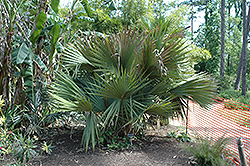It's all about ...
plants

Brazoria Palmetto Palm
Sabal x brazoriensis
Height: 20 feet
Spread: 15 feet
Sunlight:
![]()
![]()
Hardiness Zone: 8a
Other Names: Brazoria Texas Palmetto
Description:
This attractive variety is a naturally occuring hybrid tolerates drought and adapts to a wide variety of soils; the most cold hardy of the Sable Palms; a stunning landscape accent
Ornamental Features
Brazoria Palmetto Palm features showy panicles of creamy white flowers held atop the branches in mid fall. It has attractive green evergreen foliage. The lobed palmate leaves are highly ornamental and remain green throughout the winter. The fruits are showy black drupes displayed in late fall.
Landscape Attributes
Brazoria Palmetto Palm is an evergreen tree with a strong central leader and an upright spreading habit of growth. Its relatively coarse texture can be used to stand it apart from other landscape plants with finer foliage.
This is a relatively low maintenance tree, and is best pruned in late winter once the threat of extreme cold has passed. It has no significant negative characteristics.
Brazoria Palmetto Palm is recommended for the following landscape applications;
- Accent
- Vertical Accent
- Naturalizing And Woodland Gardens
- Container Planting
Planting & Growing
Brazoria Palmetto Palm will grow to be about 20 feet tall at maturity, with a spread of 15 feet. It has a low canopy with a typical clearance of 1 foot from the ground, and is suitable for planting under power lines. It grows at a slow rate, and under ideal conditions can be expected to live for 50 years or more.
This tree does best in full sun to partial shade. It does best in average to evenly moist conditions, but will not tolerate standing water. It is not particular as to soil type or pH. It is highly tolerant of urban pollution and will even thrive in inner city environments. This particular variety is an interspecific hybrid.
Brazoria Palmetto Palm is a fine choice for the yard, but it is also a good selection for planting in outdoor pots and containers. Its large size and upright habit of growth lend it for use as a solitary accent, or in a composition surrounded by smaller plants around the base and those that spill over the edges. It is even sizeable enough that it can be grown alone in a suitable container. Note that when grown in a container, it may not perform exactly as indicated on the tag - this is to be expected. Also note that when growing plants in outdoor containers and baskets, they may require more frequent waterings than they would in the yard or garden. Be aware that in our climate, most plants cannot be expected to survive the winter if left in containers outdoors, and this plant is no exception. Contact our experts for more information on how to protect it over the winter months.
This plant is not reliably hardy in our region, and certain restrictions may apply; contact the store for more information.
